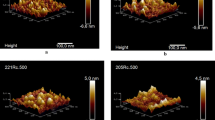Abstract
The influence of the temperature of secondary annealing, stimulating the formation of optically and electrically active centers, on the erbium ion electroluminescence (EL) at λ≈1.54 µm in (111) Si:(Er,O) diodes has been studied. The diodes were fabricated by the implantation of 2.0 and 1.6 MeV erbium ions at doses of 3×1014 cm−2 and oxygen ions (0.28 and 0.22 MeV, 3×1015 cm−2). At room temperature, the EL intensity in the breakdown mode grows with the annealing temperature increasing from 700 to 950°C. At annealing temperatures of 975–1100°C, no erbium EL is observed in the breakdown mode owing to the formation of microplasmas. The intensity of the injection EL at 80 K decreases with the annealing temperature increasing from 700 to 1100°C.
Similar content being viewed by others
References
G. Franzo, S. Coffa, F. Priolo, and C. Spinella, J. Appl. Phys. 81, 2784 (1997).
N. A. Sobolev, A. M. Emel’yanov, and K. F. Shtel’makh, Appl. Phys. Lett. 71, 1930 (1997).
N. A. Sobolev, A. M. Emel’yanov, S. V. Gastev, et al., Mater. Res. Soc. Symp. Proc. 486, 139 (1998).
A. M. Emel’yanov, N. A. Sobolev, and A. N. Yakimenko, Appl. Phys. Lett. 72, 1223 (1998).
N. A. Sobolev, Yu. A. Nikolaev, A. M. Emel’yanov, et al., Izv. Akad. Nauk, Ser. Fiz. 63, 388 (1999).
N. A. Sobolev, A. M. Emel’yanov, and Yu. A. Nikolaev, Fiz. Tekh. Poluprovodn. (St. Petersburg) 34, 1069 (2000) [Semiconductors 34, 1027 (2000)].
A. M. Emel’yanov, N. A. Sobolev, M. A. Trishenkov, and P. E. Khakuashev, Fiz. Tekh. Poluprovodn. (St. Petersburg) 34, 965 (2000) [Semiconductors 34, 927 (2000)].
N. A. Sobolev, A. M. Emel’yanov, and Yu. A. Nikolaev, Fiz. Tekh. Poluprovodn. (St. Petersburg) 33, 931 (1999) [Semiconductors 33, 850 (1999)].
N. A. Sobolev, A. M. Emel’yanov, R. N. Kyutt, and Yu. A. Nikolaev, Solid State Phenom. 67–70, 371 (1999).
J. Michel, J. I. Benton, R. F. Ferrante, et al., J. Appl. Phys. 70, 2672 (1991).
N. A. Sobolev, M. S. Bresler, O. B. Gusev, et al., Fiz. Tekh. Poluprovodn. (St. Petersburg) 28, 1995 (1994) [Semiconductors 28, 1100 (1994)].
N. A. Sobolev, O. V. Alexandrov, M. S. Bresler, et al., Mater. Sci. Forum 196–201, 597 (1995).
Author information
Authors and Affiliations
Additional information
__________
Translated from Fizika i Tekhnika Poluprovodnikov, Vol. 35, No. 10, 2001, pp. 1224–1227.
Original Russian Text Copyright © 2001 by Sobolev, Emel’yanov, Nikolaev.
Rights and permissions
About this article
Cite this article
Sobolev, N.A., Emel’yanov, A.M. & Nikolaev, Y.A. Effect of the annealing temperature on erbium ion electroluminescence in Si:(Er,O) diodes with (111) substrate orientation. Semiconductors 35, 1171–1174 (2001). https://doi.org/10.1134/1.1410659
Received:
Accepted:
Issue Date:
DOI: https://doi.org/10.1134/1.1410659




